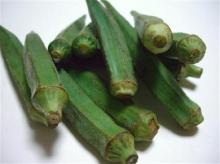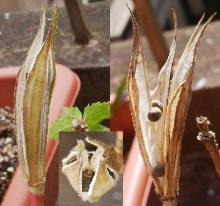Okura is known for being a slimy ingredient, as are Natto (Japanese fermented soybeans) and yams. Okra originated in the tropical regions of North Africa, grows to be 1-2m tall, and has pointed leaves and a white flower. We eat its pods (the part that contain seeds), which make Okra a little different from other plants. When exposed to dry conditions, the surface of its seeds hardens in order to keep moisture from escaping, and in this way is able to conserve valuable water within the seed. This hardening happens via the columnar cells, called the palisade cells, which are closely lined up on the surface of the seeds. These cells thicken in dry conditions, causing the surface of the seeds to harden, and helping the seeds to prevent water loss.
- Resouce/Energy/Information Collection & Storage:
- Water retention
The okra seed’s ability to contract and harden to prevent water loss during dry conditions can be utilized to develop new water retention technologies. The drier the environment, the more useful these new technologies will be. For example, it is possible to help the well-dependent water supply systems in the dry regions of central Myanmar reduce water lost through evaporation by covering the outside of the wells with the same material found in okra seeds’ exterior. Okra’s water-retention mechanisms can be used in agriculture to develop special sheets (akin to greenhouses) that cover entire vegetable fields, hardening in dry conditions in order to prevent water loss through evaporation. This would make it possible to grow crops with less water, making agriculture possible in areas that previously could not be farmed due to a lack of water. Also possible is the creation of new materials for food preservation, particularly when moisture retention is an issue. For instance, vegetables, sealed in bags or boxes created with these new materials could stay fresh for much longer than if they were stored in traditional containers on account of their ability to retain moisture. These products would be created using plant-based materials, making them easily recyclable or compostable, much like kitchen garbage, as compared to plastic bags which require a lot of energy to be buried in landfills or recycled after being used.



















